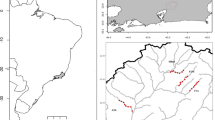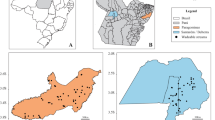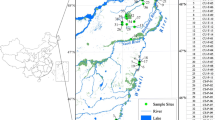Abstract
Aquatic macroinvertebrates are a biodiverse component of wetlands. Knowing the degree to which the different groups show congruence in their diversity and composition is therefore necessary if we are to optimize cost effectiveness of macroinvertebrate-based monitoring tools. Here we used published family lists of macroinvertebrate assemblages from 381 wetlands spread across the Western Palearctic and the Nearctic geographic regions, comprising both temporary and permanent waters. In order to determine the magnitude and nature of the spatial variability in the composition of molluscans, crustaceans and insects, we first examined beta diversity patterns for these groups. We then assessed which pairs of these taxonomic groups, or sub-groups (i.e. molluscan and crustacean classes, and insect orders), had a higher congruence in taxonomic richness and composition. We finally tested if any particular combination of groups could serve as a useful surrogate to estimate overall taxonomic richness. We found Mollusca composition could be better predicted than Crustacea and Insecta compositions. Mollusca (M), Hemiptera (H) and Coleoptera (C) family richnesses showed highest congruence with the rest of the groups. We subsequently combined the family richness of these groups (MHC) and observed that this metric was highly correlated with non-MHC family richness. We thus suggest that MHC should be considered when implementing new, or adapting existing, wetland biodiversity monitoring programs.


Similar content being viewed by others
References
Allen AP, Whittier TR, Larsen DP, Kaufman PR, O’Connor RJ, Hughes RM, Stemberger RS, Dixit SS, Brinkhurst RO, Herlihy AT, Paulsen RG (1999) Concordance of taxonomic composition patterns across multiple lake assemblages: effects of scale, body size, and land use. Canadian Journal of Fisheries and Aquatic Sciences 56:2029–2040
Anderson MJ (2001) A new method for non-parametric multivariate analysis of variance. Austral Ecology 26:32–46
Apfelbeck RS (2001) Development of biocriteria for wetlands in Montana. In: Rader RB, Batzer DP, Wissinger SA (eds) Bioassessment and management of North American freshwater wetlands. Wiley, New York, pp 141–166
Bagella S, Gascón S, Caria M, Sala J, Boix D (2011) Cross-taxon congruence in Mediterranean temporary wetlands: vascular plants, crustaceans, and coleopterans. Community Ecology 12:40–50
Bailey RC, Norris RH, Reynoldson TB (2001) Taxonomic resolution of benthic macroinvertebrate communities in bioassessments. Journal of the North American Benthological Society 20:280–286
Baselga A (2010) Partitioning the turnover and nestedness components of beta diversity. Global Ecology and Biogeography 19:134–143
Batzer DP (2013) The seemingly intractable ecological responses of invertebrates in wetlands: a review. Wetlands 33:1–15
Batzer DP, Ruhí A (2013) Is there a core set of organisms that structure macroinvertebrate assemblages in freshwater wetlands? Freshwater Biology 88:1647–1659
Batzer DP, Palik BJ, Buech R (2004) Relationships between environmental characteristics and macroinvertebrate communities in seasonal woodland ponds of Minnesota. Journal of the North American Benthological Society 23:50–68
Bilton DT, McAbendroth L, Bedford A, Ramsay PM (2006) How wide to cast the net? Cross-taxon congruence of species richness, community similarity and indicator taxa in ponds. Freshwater Biology 51:578–590
Bini LM, da Silva LCF, Velho LFM, Bonecker CC, Lansac-Toha FA (2008) Zooplankton assemblage concordance patterns in Brazilian reservoirs. Hydrobiologia 598:247–255
Boix D, Gascón S, Sala J, Martinoy M, Gifre J, Quintana XD (2005) A new index of water quality assessment in Mediterranean wetlands based on crustacean and insect assemblages: the case of Catalunya (NE Iberian peninsula). Aquatic Conservation: Marine and Freshwater Ecosystems 15:635–651
Bowman MF, Bailey RC (1997) Does taxonomic resolution affect the multivariate description of the structure of freshwater benthic macroinvertebrate communities? Canadian Journal of Fisheries and Aquatic Sciences 54:1802–1807
Bowman MF, Ingram R, Reid RA, Somers KM, Yan ND, Paterson AM, Morgan GE, Gunn JM (2008) Temporal and spatial concordance in community composition of phytoplankton, zooplankton, macroinvertebrate, crayfish, and fish on the Precambrian Shield. Canadian Journal of Fisheries and Aquatic Sciences 65:919–932
Briers RA, Biggs J (2003) Indicator taxa for the conservation of pond invertebrate diversity. Aquatic Conservation: Marine and Freshwater Ecosystems 13:323–330
Burton TM, Uzarski DG, Gathman JP, Gesner JA, Keas BE, Stricker CA (1999) Development of a preliminary invertebrate index of biotic integrity for Lake Huron coastal wetlands. Wetlands 19:869–882
Cairns J, Pratt JR (1993) A history of biological monitoring using benthic macroinvertebrates. In: Rosenberg DM, Resh VH (eds) Freshwater biomonitoring and benthic macroinvertebrates. Chapman & Hall, New York, pp 10–27
Chessman BC, Trayler KM, Davis JA (2002) Family- and species-level biotic indices for macroinvertebrates on the Swan Coastal Plain, Western Australia. Marine and Freshwater Research 53:919–930
Culler LE, Smith RF, Lamp WO (2014) Weak relationships between environmental factors and invertebrate communities in constructed wetlands. Wetlands 34:351–361
Davis J, Horwitz P, Norris R, Chessman B, McGuire M, Sommer B (2006) Are river based methods using macroinvertebrates applicable to wetlands? Hydrobiologia 572:115–128
Flather CH, Wilson KR, Dean DJ, McComb WC (1997) Identifying gaps in conservation networks: of indicators and uncertainty in geographic-based analyses. Ecological Applications 7:531–542
Gaston KJ (1996) Biodiversity-congruence. Progress in Physical Geography 20:105–112
Gaston KJ (2000) Global patterns of biodiversity. Nature 405:220–227
Heino J (2010) Are indicator groups and cross-taxon congruence useful for predicting biodiversity in aquatic ecosystems? Ecological Indicators 10:112–117
Helgen JC, Gernes MC (2001) Monitoring the condition of wetlands: indexes of biological integrity using invertebrate and vegetation. In: Rader RB, Batzer DP, Wissinger SA (eds) Bioassessment and management of North American freshwater wetlands. Wiley, New York, pp 167–188
Kashian DR, Burton TM (2000) A comparison of macroinvertebrates of two Great Lakes coastal wetlands: testing potential metrics for an index of ecological integrity. Journal of Great Lakes Research 26:460–481
King RS, Richardson CJ (2002) Evaluating subsampling approaches and macro invertebrate taxonomic resolution for wetland bioassessment. Journal of the North American Benthological Society 21:150–171
Kirkman LK, Smith LL, Quintana-Ascencio PF, Kaeser MJ, Golladay SW, Farmer AL (2012) Is species richness congruent among taxa? Surrogacy, complementarity, and environmental correlates among three disparate taxa in geographically isolated wetlands. Ecological Indicators 18:131–139
Lenat DR, Resh VH (2001) Taxonomy and stream ecology: the benefits of genus- and species-level identifications. Journal of the North American Benthological Society 20:287–298
Lillie RA (2003) Macroinvertebrate community structure as a predictor of water duration in Wisconsin wetlands. Journal of the American Water Resources Association 39:389–400
Longmuir A, Shurin JB, Clasen JL (2007) Independent gradients of producer, consumer, and microbial diversity in lake plankton. Ecology 88:1663–1674
McGeoch MA (1998) The selection, testing and application of terrestrial insects as bioindicators. Biological Reviews 73:181–201
Menetrey N, Oertli B, Lachavanne JB (2011) The CIEPT: a macroinvertebrate-based multimetric index for assessing the ecological quality of Swiss lowland ponds. Ecological Indicators 11:590–600
Noss RF (1990) Indicators for monitoring biodiversity: a hierarchical approach. Conservation Biology 12:822–835
Oertli B, Indermuekle N, Angelibert S, Hinden H, Stoll A (2008) Macroinvertebrate assemblages in 25 high alpine ponds of the Swiss National Park (Cirque de Macun) and relation to environmental variables. Hydrobiologia 597:29–41
Pearson DL (1994) Selecting indicator taxa for the quantitative assessment of biodiversity. Philosophical Transactions of the Royal Society B 345:75–79
R Development Core Team (2013) R: a language and environment for statistical computing. R Foundation for Statistical Computing, Vienna
Rosenberg DM, Resh VH, King RS (2008) Use of aquatic insects in biomonitoring. In: Merritt RW, Cummins KW, Berg MB (eds) An introduction to the aquatic insects of North America. Kendall/Hunt, Dubuque, pp 123–138
Ruhí A, Boix D, Gascón S, Sala J, Batzer DP (2013) Functional and phylogenetic relatedness in temporary wetland invertebrates: current macroecological patterns and implications for future climatic change scenarios. PloS One 8:e81739
Ruhí A, Chappuis E, Escoriza D, Jover M, Sala J, Boix D, Gascón S, Gacia E (2014) Environmental filtering determines community patterns in temporary wetlands: a multi-taxon approach. Hydrobiologia 723:25–39
Sánchez-Fernández D, Abellán P, Mellado A, Velasco J, Millán A (2006) Are water beetles good indicators of biodiversity in Mediterranean aquatic ecosystems? The case of the Segura river basin (SE Spain). Biodiversity and Conservation 15:4507–4520
Stewart TW, Downing JA (2008) Macroinvertebrate communities and environmental conditions in recently constructed wetlands. Wetlands 28:141–150
Tangen BA, Butler MG, Michael JE (2003) Weak correspondence between macroinvertebrate assemblages and land use in Prairie Pothole Region wetlands, USA. Wetlands 23:104–115
Vanschoenwinkel B, Seaman M, Brendonck L (2010) Hatching phenology, life history and egg bank size of fairy shrimp Branchipodopsis spp. (Branchiopoda, Crustacea) in relation to the ephemerality of their rock pool habitat. Aquatic Ecology 44:771–780
Vellend M, Lilley PL, Starzomski BM (2008) Using subsets of species in biodiversity surveys. Journal of Applied Ecology 45:161–169
Vinson MR, Hawkins CP (2003) Broad-scale geographical patterns in local stream insect genera richness. Ecography 26:751–767
Wallace JB, Grubaugh JW, Whiles MR (1996) Biotic indices and stream ecosystem processes: results from an experimental study. Ecological Applications 6:140–151
Wilcox DA, Meeker JE, Hudson PL, Armitage BJ, Black MG, Uzarski DG (2002) Hydrologic variability and the application of index of biotic integrity metrics to wetlands: a great lakes evaluation. Wetlands 22:588–615
Wissinger SA, Brown WS, Jannot JE (2003) Caddisfly life histories along permanence gradients in high-altitude wetlands of Colorado (USA). Freshwater Biology 48:255–270
Author information
Authors and Affiliations
Corresponding author
Electronic Supplementary Material
Below is the link to the electronic supplementary material.
ESM 1
(DOC 39 kb)
Rights and permissions
About this article
Cite this article
Ruhí, A., Batzer, D.P. Assessing Congruence and Surrogacy Among Wetland Macroinvertebrate Taxa Towards Efficiently Measuring Biodiversity. Wetlands 34, 1061–1071 (2014). https://doi.org/10.1007/s13157-014-0566-6
Received:
Accepted:
Published:
Issue Date:
DOI: https://doi.org/10.1007/s13157-014-0566-6




